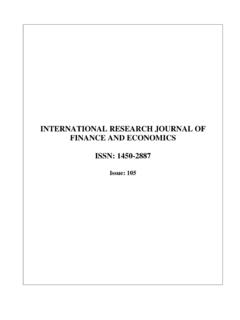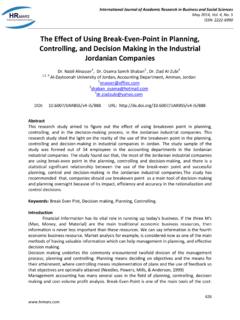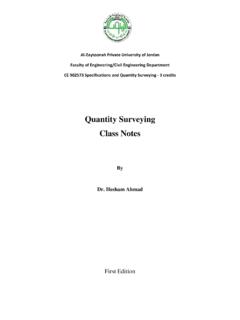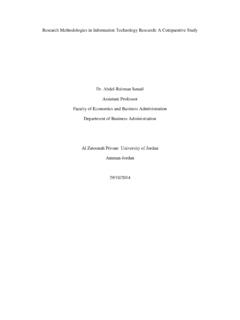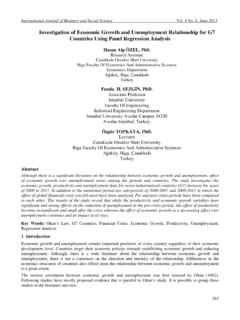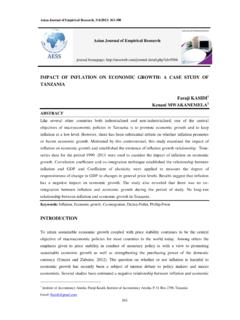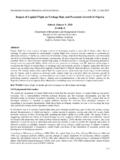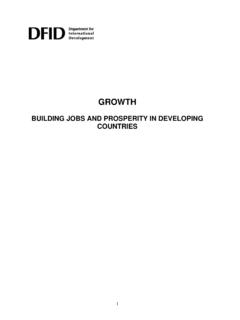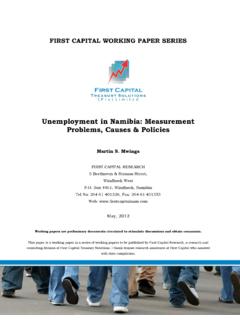Transcription of The Relationship between Unemployment and …
1 Journal of Economics and Sustainable Development ISSN 2222-1700 (Paper) ISSN 2222-2855 (Online) , , 2014 56 The Relationship between Unemployment and Economic Growth Rate in Arab Country Shatha Abdul-Khaliq* Assistant Professor,Al Zaytoonah University of Jordan. E-mail: Thikraiat Soufan Assistant Professor,Al Zaytoonah University of Jordan. E-mail: Ruba Abu Shihab Assistant Professor ,AlBlqa Applied University, Jordan The research is financed by Asian Development Bank. No. 2006-A171(Sponsoring information) Abstract The main purpose of this paper is to examine the Relationship between Unemployment and GDP growth in Arab countries.
2 We consider 9 Arab Countries between 1994 and 2010. The model adopted for testing the Relationship is the Pooled EGLS (Cross-section SUR). It has been found that economic growth has negative and significant effect upon the Unemployment rate it means that 1% increase in economic Growth will decrease the Unemployment rate by Keywords: Economic growth, Unemployment , GDP, Okun s law, panel, Arab countries. : Potential output is seen as the aggregate output produced in an economy, when all factors especially human resources are gainfully employed or fully utilized. It is the maximum level of durably sustainable production, without tension in the economy, and more precisely without acceleration of inflation.
3 Conversely, real output is the national output produced when some units of factors still remained virtually unemployed. Thus, the gap between the potential GDP and real GDP spreads out the variations in Unemployment which are in turn inversely related to changes in output. This Relationship was first recognized and empirically estimated by Okun (1962), which is now commonly called Okun's law. okun s law is an empirical Relationship between changes in aggregate output (relative to its potential trend) and changes in the Unemployment rate (relative to its natural rate). In other words, this law is intended to tell us how much of a country s gross domestic product (GDP) may be lost when the Unemployment rate is above its natural rate.
4 The study is structured into 3 sections: section (1) deals with the literature review; section (2) discusses methodology and data; while analysis of results, conclusion and recommendations are presented in section (3). : The hypotheses is: Ho: There is no significant Relationship between Unemployment and economic growth. Review: A lot of studies exist on the causality between Unemployment and economic growth. We summarize some studies that addressed this issue as follows: Bankole and Fatai (2013) estimated the Okun s coefficient, and checked the validity of Okun s law in Nigeria, using the time series annual data during the period 1980-2008.
5 Engle granger co-integration test and Fully Modified OLS were employed. The empirical evidences showed that there is positive coefficient in the Regression, implying that Okun s law interpretation is not applicable to Nigeria. It was recommended that government and policy makers should employ economic policies that are more oriented to structural changes and reform in labor market . Ball, Leigh, and Loungani ( 2012) asked how well Okun s Law fits short-run Unemployment movements in the United States since 1948 and in twenty advanced economies since 1980. And found that Okun s Law is a strong and stable Relationship in most countries, one that did not change substantially during the Great Recession.
6 Accounts of breakdowns in the Law, such as the emergence of jobless recoveries, are flawed. Also found that the coefficient in the Relationship the effect of a one percent change in output on the Unemployment rate varies substantially across countries. This variation is partly explained by idiosyncratic features of national labor markets, but it is not related to differences in employment protection legislation. Owyang and Sekhposyan ( 2012), examined whether Okun s law contributed to the the Great Recession of Journal of Economics and Sustainable Development ISSN 2222-1700 (Paper) ISSN 2222-2855 (Online) , , 2014 57 they considered various specifications of Okun s law to assess the degree of time variation in the Unemployment and output fluctuations over the business cycle.
7 And payed particular attention to the three most recent recessions and the Great Recession. The paper found a great degree of instability in the historical performance of Okun s law. The breakdowns in Okun s law seem to be highly correlated with the business cycle: The detected break dates of the largest changes inthe coefficients appear to be around recessions. The most robust finding of this study is that recessions contribute to the increase in the Unemployment rate on average. The correlation between Unemployment and output fluctuations changes significantly during the Great Recession and the three most recent recessions. The statistical significance of the slope changes depends on the specification at hand.
8 Nevertheless, it appears that periods of high Unemployment are correlated with increased sensitivity of the Unemployment rate to output growth or gap fluctuations, though these shifts might not always result in significant changes . Irfan Lal et al. (2010), estimated the Okun s coefficient, and checked the validity of Okun s law in some Asian countries, for this purpose they used the time series annual data during the period 1980-2006. Engle Granger (1987) co integration technique is employed to find out long run association between variables and error correction mechanism (ECM) is used for short run dynamic. After getting empirical evidences it can be said that Okun s law interpretation may not be applicable and also the principle of NAIRU does not hold its validity in some Asian developing countries.
9 Pierdzioch et al. (2009) used data covering the period 1989-2007 for G7 countries test relevance of Okun s law to professional economist s forecasts of output growth and Unemployment . Their results confirmed the consistency between Okun s law and professional conomists forecasts of changes in Unemployment rate and the real output growth rate. They also found a direct Relationship between magnitude of Unemployment and the size of the output gap. In a nut-shell, literature reveals that Okun s law has been revisited in several countries where the disparity between real output and Unemployment is alarming. Therefore, it is imperative to test for the empirical validity of this law in Nigeria where this disparity is even more alarming.
10 Noor, Nor and Judhiana (2007) examined whether there exist an Okun type Relationship between output and Unemployment in the Malaysian economy. The empirical results show that there was an inverse Relationship between output and Unemployment . Naimy (2005) applied Okun-type Relationship to the Lebanese equation in order to estimate the Lebanese potential output. An empirical study covering 400 households is carried out to investigate the employment status using the BLS criterion in determining the most useful measures of the labor market . The main finding was that the impact of Unemployment in Lebanon seems to be extremely harmful: the economy is $32 billion below its potential output.
